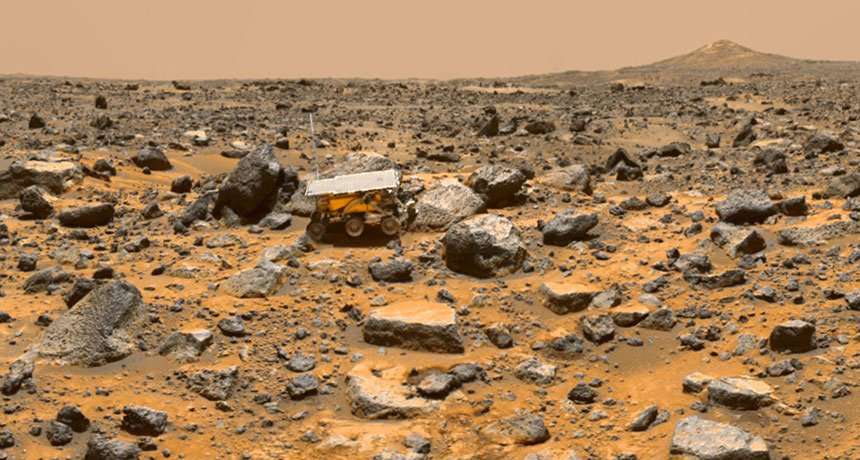Mars was a fully formed planet — crust and all — within just 20 million years of the solar system’s birth. That rapid formation means the Red Planet probably got a 100-million-year jump on Earth in terms of habitability, new research suggests.
Geochemical analyses of crystals of the mineral zircon extracted from Martian meteorites reveal that Mars had formed its earliest crust by 4.547 billion years ago, scientists report June 27 in Nature. That’s just 20 million years after the disk of gas around the sun gave birth to the solar system’s planets.
The emergence of a planet’s outermost shell, or crust, is the final stage in the formation of terrestrial planets like Mars, Earth, Venus and Mercury. The process begins with the accretion of particles from the protoplanetary gas disk; eventually, those particles form molten material that makes up a hot magma ocean. As the magma ocean cools and crystallizes, it forms a dense metallic core, and then an outer crust. Simulations of the whole process takes suggest this occurs on timescales of 30 million to as long as 100 million years.
Analyses of the Martian zircons, led by planetary scientist Laura Bouvier of the University of Copenhagen, suggest that Mars’ crust formed much more rapidly, however. The team analyzed isotopes in seven of the crystals. Isotopes are forms of an element that have the same number of protons but different numbers of neutrons, and therefore different masses. Some isotopes are unstable, and radioactively decay into other elements at known rates. Using the decay of uranium-235 to lead-207 and of uranium-238 to lead-206, Bouvier and her team determined that the zircons are as much as 4.476 billion years old.
The team next turned to another radioactive isotopic decay system, lutetium-176 to hafnium-176 — and discovered that Mars’ earliest crust is even older. Zircons crystallizing from such rocks should have contained much more hafnium than the researchers found in their analyses. Based on the amount of hafnium present and the lutetium-hafnium decay rates, the team calculated that the original magma crust must have solidified around 4.547 billion years ago.
Sometime after that, heavy bombardment by asteroids partially melted that crust, although the impacts didn’t turn it completely back into a magma ocean, the researchers suggest. The zircons containing traces of this earlier crust were born when, around 4.476 billion years ago, Mars cooled down again for good.
“Having Mars cool so quickly puts limits on how massive its atmosphere could have been,” says Linda Elkins-Tanton, a planetary scientist at Arizona State University in Tempe who wrote a commentary that accompanies the new study. Going by how quickly a planet cools and how quickly the sun can strip away its atmosphere, researchers can estimate how much water and carbon dioxide might have been released by the magma ocean to form an early atmosphere. But in Mars’ case, that atmosphere would have been pretty thin to allow for such rapid heat loss, Elkins-Tanton says.
Mars also would have solidified about 100 million years before Earth did — giving the Red Planet a head start on habitability. Our home planet was almost certainly fully molten at that time, possibly thanks to a giant whack that formed the moon and remelted the entire planet, Elkins-Tanton says. (SN: 4/15/17, p. 18) “That restarted everything on Earth.”

joel8163 on June 27th, 2018 at 22:04 UTC »
Never forget that Mars blew a 100 million year lead
kilobitch on June 27th, 2018 at 20:44 UTC »
Mars, you slacker! You should have had 100 million year old civilizations by now!
JollyGreen39 on June 27th, 2018 at 18:09 UTC »
I’m sure the whole ‘formation of the moon’ thing kinda set us back a bit.